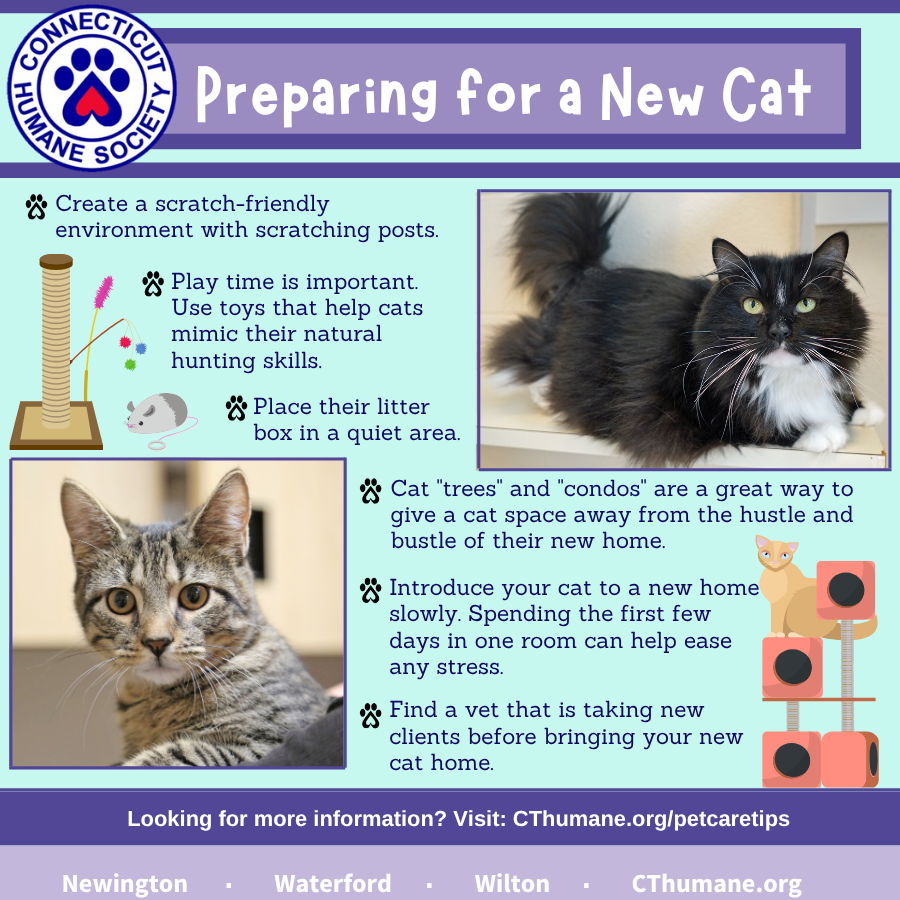
“What pet should I get?” It’s not just the title of a Dr. Suess book, it’s a question often heard from a first-time visitor to the Connecticut Humane Society. You’ve already thought about the pros and cons and whether or not you’re ready to get a pet, but you still might be on the fence about what type of pet you want. Or maybe you just adopted a pet, and you want to make sure you’ve covered all your bases. Check out these tips to start.
Lazy, playful. Independent, snuggly. Cats, like people, all have different personalities… or should we say purr-sonalities?
Diet
When you adopt your pet, speak with the adoption counselor, breeder, or prior owner about what the cat has been eating. You might want to keep feeding that particular food, or you might choose to transition your kitty to a different diet. If you choose to change the food, recognize that your cat is going through a lot of change – a new home, family, and routine. Transition to the new food gradually – your cat food label may have guidance. A little bit more of the new food (and a little less of the old diet) each day will make the change easier on your kitty’s tummy, and one less thing to worry about as you two adapt to each other.
A cat’s food should be divvied up into measured meals each day. Some cats graze on their food all day, others will need you to portion out their meals. The quantity, frequency, and formula of food should be appropriate for the cat’s age, weight, breed and size; your veterinarian can help you select the right food for your pet.
Make sure your kitty has access to clean, fresh water every day.
Housing and Enrichment
Indoor cats live longer than their outdoor counterparts, as they’ll be safe from traffic, predators like coyotes, and fights with cats and other animals. But life indoors can get boring, never mind the health challenges that can pop up due to a sedentary lifestyle (obesity, diabetes and more). Here are some ideas to keep your cat both physically and mentally healthy:
- Invest in toys and scratching posts. There’s an ever-expanding diversity of toys available, both homemade and available in stores. Time will tell what your kitty will prefer – jingle balls, catnip-filled mice, playing chase with a wire-toy and more. Rotate the toys available to your cat to keep things fresh and exciting.
- Some cats can be conditioned to a leash and harness, allowing them to enjoy the great outdoors with you by their side.
- Got windows? Give your kitty a perch to look out the window (make sure the screens are secure!).
- Some cats like watching – and hearing – chirping bird videos. If only their paws could navigate to YouTube on their own…
- Got space or a yard? Maybe you like DIY projects. Google “catios” and get a hold of enclosures to let your kitty enjoy the great outdoors safely?
Litterbox
Your kitty’s litterbox should be placed in a quiet, accessible location in your home. In a multi-cat home, each cat should have their own litterbox – and if space allows, one extra too. Cats can be picky about their litterbox – clean it daily. If you’re seeing accidents, you may try a few different kinds of litter before you get it right.
Grooming
Kitties need a grooming regimen appropriate for their coat type. You may choose to groom your cat yourself, or enlist the help of a professional groomer. Pets with long fur may need to be brushed more frequently than cats with shorter hair.
Are kitty’s nail’s catching when she walks on carpet? You may need to trim them. Always provide a scratching post – cat’s need to scratch! Try different materials (carpet, cardboard, etc.) and layouts (hanging, flat, angled, etc.) to find the right one for your pet.
Veterinary Care
Annual check-ups with your veterinarian and monitoring your cat for any lumps, bumps, sniffles, change in energy, diet, and more will keep them on the right track. With proper care that includes a healthy diet, regular check-ups, vaccines and preventative medication, indoor cats can live 10 years or more.
Check out the video below for kid-friendly cat care tips.
